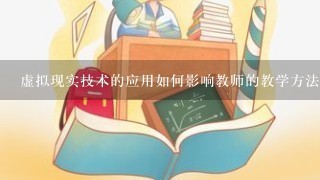虚拟现实技术的应用如何影响教师的教学方法?

虚拟现实技术的应用如何影响教师的教学方法?
1. 增强教学内容的多样性
- Teachers can create more engaging lessons by incorporating virtual reality experiences into their curriculum.
- Students can explore historical sites, conduct simulations, or engage in hands-on activities that would be difficult or impossible in a traditional classroom setting.
2. 促进学生参与度
- VR experiences can immerse students in the learning environment, making it more interactive and engaging.
- Students can collaborate with peers in virtual worlds, fostering teamwork and communication skills.
3. 提高学生的学习兴趣
- VR experiences can make learning more immersive and enjoyable, motivating students to participate actively.
- Students can learn about complex concepts in a unique and memorable way.
4. 促进批判性思维
- VR experiences require students to think critically about the environment and their surroundings.
- They must solve problems, make decisions, and adapt to changing situations.
5. 培养学生的创造力和问题解决能力
- VR experiences allow students to explore and create in a safe and controlled environment.
- They can develop their creativity, problem-solving skills, and critical thinking abilities.
6. 促进学生与老师的互动
- VR can provide a platform for teachers to interact with students in a more immersive way.
- They can provide feedback, guide students through experiences, and offer real-time support.
7. 提高学生的学习效率
- VR experiences can provide students with additional practice opportunities outside of the classroom.
- They can review information, practice skills, and reinforce concepts in a fun and engaging way.
8. 促进学生的个人兴趣
- VR experiences can introduce students to new topics and interests, fostering their curiosity and motivation.
- They can explore different cultures, historical periods, and scientific concepts.
9. 改善学生的学习成果
- Studies have shown that students who use VR in the classroom achieve better results in terms of engagement, knowledge retention, and problem-solving skills.
- VR experiences can provide a valuable tool for differentiated instruction and personalized learning.





































































